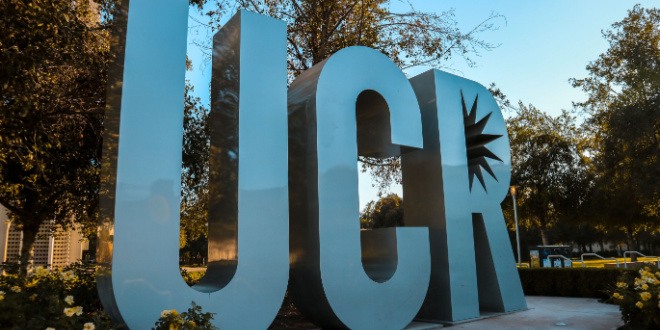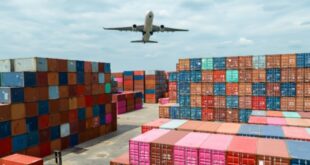Warehouse-distribution facilities have come to dominate the Inland Empire during the past 20 to 25 years, so much so that the region is sometimes called the warehouse of the western United States.
The amount of available and affordable land in Riverside and San Bernardino counties, along with the region’s proximity to the Los Angeles and Long Beach ports, have made it a natural place for businesses of all sizes to store and package their goods before shipping them to the rest of the country.
As of 2023, “transportation and warehousing,” accounted for 16.4 percent of all jobs in the Inland Empire, making that sector the region’s largest employer, according to a recent 63-page study of the logistics industry in the two-county region.
Released Feb. 28, The State of Work: Transportation, Distribution and Logistics in the Inland Empire is a joint project undertaken by UC Riverside’s Labor and Community Center, the university’s Center for Social Innovation and the Inland Empire Labor Institute, a non-profit backed by the AFL-CIO that seeks to increase union membership and improve working conditions for local blue collar employees.
The study, which includes interviews with 32 people either employed or formerly employed in the Inland logistics industry, is probably the most comprehensive analysis ever undertaken on that subject.
It notes that employment in transportation and warehousing in the two-county region grew 84 percent between 2017 and 2022, that Riverside and San Bernardino counties are home to 69 percent of Southern California’s warehouse-distribution facilities, and that 2,275 of those facilities were built in the Inland region between 2005 and 2021.
Perhaps most significant of all, the Inland Empire today has approximately one billion square feet of warehouse space within its borders, and it’s waiting for another 170 million square feet to go online.
Those numbers clearly show why transportation, distribution and logistics – or TDL, as it’s referred to in the study – have come to dominate the Inland economy.
But that domination has come with a price: long hours and low pay for many who work in those facilities, and concerns about the damage being done to the environment – and some Inland residents – by the trucks that move in and out of them, often 24 hours a day.
The sheer number of warehouse-distribution centers in the Inland Empire has raised concerns about more than just poor working conditions.
Traffic, health and air quality have also become major issues, leading some to wonder when, if ever, the Inland Empire will get its fill of logistics operations.
“I was happy UC Riverside did this study, because it gives us credibility,” said Ana Gonzalez, executive director Center For Community Action and Environmental Justice in Jurupa Valley, which was formed, in part, to slow down logistics development in Riverside and San Bernardino counties.
Gonzalez and her colleagues focus much of their effort in low-income communities, because they believe that’s where the mega-warehouses, and the traffic they generate, are doing the most damage to the environment.
“They did a lot of research and they came to the same conclusions we have about all of these warehouses in the Inland Empire,” Gonzalez said. “They’re making huge profits for corporations but not for the community, and they’re damaging people’s health.”
Gonzalez repeated a common criticism of logistics facilities, one often stated by Penny Newman, Gonzalez’ predecessor and the founder of the nonprofit: yes, they create jobs, but warehouse-distribution centers have no point-of-sale, so they generate no sales tax revenue for their communities.”
They can also create serious health risks within their communities, according to the study.
People who live near warehouse-distribution centers run a higher risk of getting asthma or cancer. In some Riverside County neighborhoods, the asthma rate is higher than 15 percent, while in some parts of San Bernardino County that number is close to 20 percent.
In the cluster of warehouses near Ontario International Airport, the risk of getting cancer is in the 95th percentile.
The report aims some of its harshest observations at the pay scale in logistics facilities, which very often do not pay a livable wage or provide adequate healthcare benefits, particularly for people who perform the most difficult tasks.
The three lowest paid occupations – packers/packagers, laborers and stockers/order fillers – have an average of $700 left every month after they’ve paid their rent and other bills, including food, transportation, child care, health care and utilities.
“The findings suggest that these workers struggle to pay their basic bills,” the report states. “Many likely rely on help from friends, family or social assistance programs. (But) managers can have about $3,000 per month for non-housing related expenses after paying their rent.”
Warehouse-distribution centers will start paying higher wages as they become more automated, but as that trend progresses they won’t provide as many jobs, said Jay Prag, professor of economics at the Drucker School of Management at Claremont Graduate University.
Critics of the Inland Empire’s logistics industry might be underestimating how important that industry has been to the local economy, according to Prag.
“They have had a huge impact on the local economy, and some of the places where they’ve been built were goring broke before they arrived,” Prag said “One of them, San Bernardino, went bankrupt before the warehouse-distribution centers really started to go online.”
The logistics industry might have kept people out of poverty in some parts of the Inland region, Prag said.
“They aren’t middle-class jobs, but they’re better than no job at all,” Prag said. “Working in a warehouse-distribution center is better than no job at all. I think a person will learn better job skills doing that than they will flipping burgers.”
 IE Business Daily Business news for the Inland Empire.
IE Business Daily Business news for the Inland Empire.



What a poor concept. Massive job creation for non-skilled workers and this article suggests they’ll get cancer or asthma? Really?
Let’s get real here. These warehouses are a godsend to thousands of workers who were previously laid off by Kaiser or were driving into LA or OC for a job. Now they’re in the IE..
i”m so tired of the whining over not getting rich doing low-tech jobs. It’s fundamentally insane to assume you’ll get rich working in a warehouse BUT you might actually learn a thing or two and use that knowledge to improve your station. You’ll get out of it what you put into it.